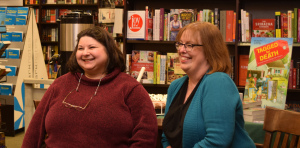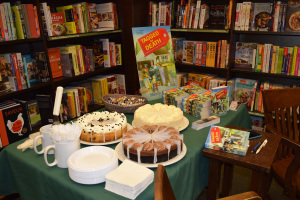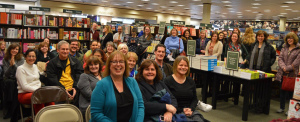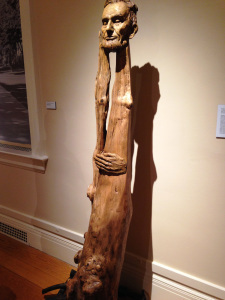Sherry Harris's Blog, page 29
January 19, 2015
Launch Parties — To Party or Not to Party
By Sherry — I’m happy it’s warmer than last week!
Launch Parties. I wasn’t sure if I should throw one or not. I googled Launch Parties and panic set in. I saw discussions about bartenders, DJs, swag, decorations, themes. That was not for me.
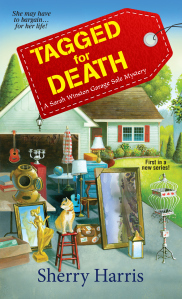 For a extroverted person I have this introverted part of me around promoting Tagged for Death. Standing up on my own, talking about my book scared the heck out of me. But that’s when I saw Ray Daniel’s post on Facebook talking about his launch party for Terminated. He had Hank Phillippi Ryan interview him. I thought that was a brilliant idea and something that would work well for me. Friends who attended Ray’s launch said it was fabulous.
For a extroverted person I have this introverted part of me around promoting Tagged for Death. Standing up on my own, talking about my book scared the heck out of me. But that’s when I saw Ray Daniel’s post on Facebook talking about his launch party for Terminated. He had Hank Phillippi Ryan interview him. I thought that was a brilliant idea and something that would work well for me. Friends who attended Ray’s launch said it was fabulous.
I asked friend, author, and independent editor Barb Goffman if she would interview me for the launch. Barb is also a journalist, funny, and enthusiastic. She said yes and a weight fell off my shoulders. I could do this. The next step was figuring out the venue. Have it at home? Rent a community center? Or have it at a bookstore? I sought the advice of friends. Some of their answers surprised me: make sure there’s lots of parking, bonus points for free parking, don’t make me drive through rush hour (Washington DC traffic can be a nightmare). Do you want this to be a marketing event or a celebration with family and friends? If you have it at your house or a community center who will handle book sales?
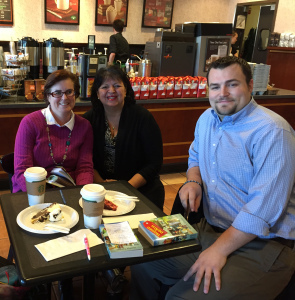 It was a lot to ponder. Fortunately for me my friend Mary Titone pushed me and called venues for me. Barnes and Noble at Fair Lakes Promenade in Fairfax, Virginia said they’d love to host my launch. Having it there fulfilled the lots of free parking and who would sell books suggestion. We set it up for 1:00 pm on a Sunday which avoided rush hour. Having it at the bookstore allowed for both a celebration and a marketing event.
It was a lot to ponder. Fortunately for me my friend Mary Titone pushed me and called venues for me. Barnes and Noble at Fair Lakes Promenade in Fairfax, Virginia said they’d love to host my launch. Having it there fulfilled the lots of free parking and who would sell books suggestion. We set it up for 1:00 pm on a Sunday which avoided rush hour. Having it at the bookstore allowed for both a celebration and a marketing event.
The staff at Barnes and Noble couldn’t have been nicer. Store manager Sarah Emmett arranged for Mary and I to meet with Ann, who’s in charge of the cafe, and John their events guru. Ann provided samples of baked goods and made sure I stayed within my budget. The day of the launch she even made sure we had our own private “butler” Alex to serve. John and Sarah made lots of great suggestions and showed us the space where the party would be. They all seemed so happy about the event and I couldn’t have worked with a nicer team.
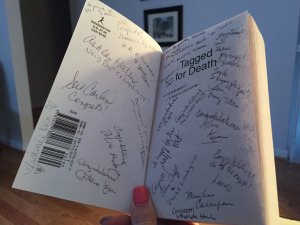 The night before the big day my friend Jill Ribler sent me a picture she’d found on Pinterest. An author had taken her own book and had people attending the launch sign it instead of having a guest book. It was a great idea which I incorporated into the launch. Two friends and fellow writers, Susan O’Brien and Robin Templeton, volunteered to take pictures.
The night before the big day my friend Jill Ribler sent me a picture she’d found on Pinterest. An author had taken her own book and had people attending the launch sign it instead of having a guest book. It was a great idea which I incorporated into the launch. Two friends and fellow writers, Susan O’Brien and Robin Templeton, volunteered to take pictures.
The launch itself was perfect. I choked up a bit during the thank you’s when I mentioned my husband and daughter. Barb Goffman was funny and asked great questions. Having her by my side kept me calm (well, calmer). I didn’t do a reading — it’s another thing I’m not crazy about doing.
I was delighted to have people from so many aspects of my life present. Friends we’d met at Hanscom Air Force Base in Massachusetts — Tagged for Death is set in a fictional version of the base and the small town of Bedford, Massachusetts, Chessie Chapter Sisters in Crime members, even one friend from the New England Chapter of Sisters in Crime, one Wicked Cozy Author, along with friends and neighbors. It surpassed the celebration I hoped for.
Thanks to all of you for making my launch party such a special day!
Filed under: Sherry's posts Tagged: Barb Goffman, Barnes and Noble, Bedford Massachusetts, Chessie Chapter of Sisters in Crime, Fair Lakes Promenade, Fairfax, hank phillippi ryan, Hanscom Air Force Base, Launch Parties, Mary Titone, New England Chapter of Sisters in Crime, Ray Daniels, Sarah Emmett, Terminated, VA

January 16, 2015
Welcome Back, Author Lea Wait
by Barb, in sunny, warm Key West (don’t hate me)
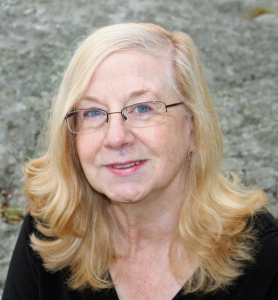 Regular readers of the blog will remember my friend author Lea Wait was here in September. Then she talked about the latest book in her Shadows Antique Print series, Shadows on a Maine Christmas. At the time, she mentioned her new Mainely Needlepoint mystery series was coming soon. Well now the first book in the series, Twisted Threads, is here and we’ve asked Lea back to answer some questions about it.
Regular readers of the blog will remember my friend author Lea Wait was here in September. Then she talked about the latest book in her Shadows Antique Print series, Shadows on a Maine Christmas. At the time, she mentioned her new Mainely Needlepoint mystery series was coming soon. Well now the first book in the series, Twisted Threads, is here and we’ve asked Lea back to answer some questions about it.
About Twisted Threads: Angie Curtis had a rough Maine childhood, which only got worse when she was ten and her mother disappeared. At eighteen, Angie took off for any place other than Maine and ended up working for a private investigator in Arizona. Now she’s 28, her mother’s body has been found, and Angie returns to Haven Harbor vowing to find her mother’s killer. When she finds her grandmother’s needlepoint business is in trouble, she also agrees to help out there. She doesn’t know “helping out” will mean solving another murder, and confronting some of her childhood fears.
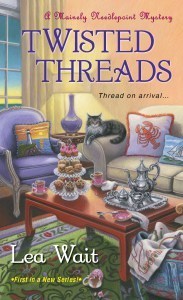 Barb: While you’ve always written more than one thing, because you write for children and adults, Twisted Threads is the first book in your second mystery series for adults. How did you think about creating a second series? Was it a very different experience than creating the world of the Shadows mysteries?
Barb: While you’ve always written more than one thing, because you write for children and adults, Twisted Threads is the first book in your second mystery series for adults. How did you think about creating a second series? Was it a very different experience than creating the world of the Shadows mysteries?
Lea: When I started the Shadows series I hadn’t been published. Truthfully, I wrote the first in the series (Shadows at the Fair) to prove to myself that I could sustain a book-length manuscript. I was focused on writing one book at a time. For fun, I made each Shadows Antique Print mystery reflect a different classic mystery tradition, from the Gothic house mystery (Shadows on the Coast of Maine) to the academic mystery (Shadows on the Ivy) to the wedding mystery (Shadows on a Cape Cod Wedding) and the Christmas mystery (Shadows on a Maine Christmas).
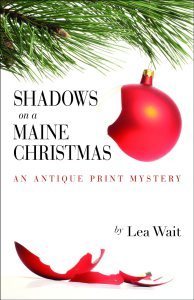 I was a beginner: I didn’t think through my decision to set different books in the series in different places. (Maggie Summer is an antique print dealer who travels to do antique shows and visit friends.) Some readers who grew attached to various characters, like Maggie’s best friend, Gussie, wanted their favorites to appear in every book in the series. I’d consciously hoped to avoid the “Cabot Cove” syndrome in which eventually everyone in the village seems destined to die. But, instead, I set up a different challenge.
I was a beginner: I didn’t think through my decision to set different books in the series in different places. (Maggie Summer is an antique print dealer who travels to do antique shows and visit friends.) Some readers who grew attached to various characters, like Maggie’s best friend, Gussie, wanted their favorites to appear in every book in the series. I’d consciously hoped to avoid the “Cabot Cove” syndrome in which eventually everyone in the village seems destined to die. But, instead, I set up a different challenge.
I know a lot more about writing mysteries now than I did when I set up the Shadows series!
Barb: Angie Curtis in the Mainely Needlepoint series is a very different protagonist than Maggie Summers in the Shadows mysteries. They’re different ages and have vastly different backgrounds. Because of this, the challenges they deal with and their goals are very different as well. How did you create Angie Curtis? Was it a conscious goal to keep her so far away from Maggie?
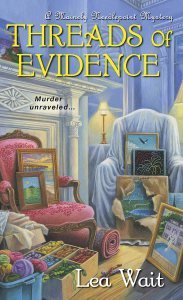 Lea: Yes! Angie is a high school graduate who grew up in Maine. She’s single and street-smart and 28. She’s worked for a private investigator, she knows how to shoot, she’s been known to drink too much, and there have been more men in her life than she’s willing to admit to anyone but herself.
Lea: Yes! Angie is a high school graduate who grew up in Maine. She’s single and street-smart and 28. She’s worked for a private investigator, she knows how to shoot, she’s been known to drink too much, and there have been more men in her life than she’s willing to admit to anyone but herself.
Maggie, on the other hand, grew up in suburban New Jersey, has a doctorate and is both a professor and an antique print dealer. She’s a widow in her late 30s who is hearing her time clock tick … she wants to be a mother. She has issues, too: she’s sometimes too focused on her jobs or on solving a crime to think of other people. And after a poor marriage, she has trouble trusting men.
Maggie can be brave; Angie can be reckless. Maggie wants to settle down; Angie needs to resolve issues left over from her childhood.
The Shadows books are from Maggie’s point of view, but written in the third person. The Mainely Needlepoint series is written in first person, so we see the world through Angie’s eyes.
As a writer, I wanted to challenge myself by choosing a heroine who was very different from Maggie. And I’m having a lot of fun learning to know Angie!
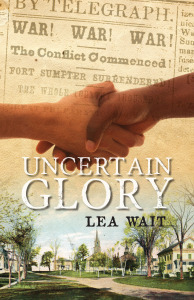
Uncertain Glory, Lea’s 2014 book for young people
Barb: Twisted Threads takes place in a harbor town in Maine, a setting I know you know a little something about. How did you create Harbor Haven and how is it both different than and similar to your real Maine town?
Lea: Hmmm. Yes. You do have a bit of knowledge about Maine harbor towns. I love both your home in Boothbay Harbor … and your books set in Busman’s Harbor!
The Shadow series does include a Maine community. Weymouth, a fictional village, is on a tidal river, very similar to real Maine towns like Bath and Wiscasset and Damariscotta. Again, in setting up a new series I wanted a new setting. Haven Harbor, Angie’s home town, looks out to sea. It has a working waterfront, a few tourist areas, and its own lighthouse and islands. (But no clam bakes!) It is more similar to your Boothbay Harbor, and to Belfast, and other towns in Down East Maine.
Barb: What are you working on now?
Lea: Kensington, the publisher we share, wanted a new Mainely Needlepoint book every six months (!) So this month I’m celebrating the publication of Twisted Threads, doing copy edits on Threads of Evidence, which will be published next August, and writing Thread and Gone, the third in the series. When I hit a rough spot or really need a break I work on the next Shadows book … Shadows on a Maine Morning. So – not bored in Maine this winter!
Readers–do you have a question or comment for Lea?
Biography: Maine author Lea Wait writes the 7-book Shadows Antique Print Mystery series and historical novels for young readers set in 19th century Maine. She adopted her four daughters as a single parent; now she’s the grandmother of eight, and married to artist Bob Thomas. For more information about Lea and her books, see her website www.leawait.com, and friend her on FB and Goodreads.
Filed under: Guest posts Tagged: Mainely Needpoint Mysteries, shadows antique prints mystery, Shadows on a Maine Christmas, threads of evidence, Twisted Threads

January 15, 2015
It’s A MARVELous World
By Julie, cold but cozy in Somerville
As I confessed in the comments when Jessie asked “To Binge or Not To Binge“, I am a Marvel fan. Movies and TV. Iron Man. Captain America. Thor. Agents of Shield. Agent Carter. The Avengers.
I am late to discovering this universe, and often need to be brought up to speed on backstory. A simple Facebook post asking “what is Captain America’s shield made of and why don’t they just shoot his ankles” brought forth several explanatory comments, including some citatations to different articles and explanations. There is an entire Marvel Encyclopedia. I am tempted.
Aside from the visceral thrill of super hero movies, these movies and TV shows are a great learning tool for me as a writer. Here’s what the Marvel world has taught me:
The best characters are complicated. The good guys are good guys, but they have struggles. Some of them walk a fine line, but usually end up on the right side.
You can create your own universe, but you still need to follow the rules you set up. Go outside the construct without explanation,and there needs to be a good reason, or reprecussions.
Story arcs are important. Apparently, the Marvel world of films has three phases. Each movie stands on its own, but knowing the other films helps inform the experience tremendously. The TV shows interweave with the movies. It all, surprisingly, makes sense. Also, threads are left hanging, to be resolved (or not) later.
The stories are well plotted. Each film is a little different, depending on the character, the screenplay, and the director. But they all move along at a satisfying clip.
The ride is thrilling. That is tougher to pull off in a book, but not impossible.
There is humor. Humor helps a lot.
Pulling all of this off, at this scale, is no small feat. It has been done before (any Babylon 5 fans out there?) and will be done again. Certainly a cozy series can’t have a visit by Captain America, but maybe it can be elevated by using a little Asgardian power plotting, a Stark Heart, Black Widow moves, and Avenger’s magic.
In fact, Marvel movies remind me a lot of cozy series (familiar characters, compelling stories, consistent settings) without the superpowers.
But don’t be surprised if Ruth Clagan (the protaganist in my series) wears a cape at some point.
Have any of you watched Agent Carter yet? I am greatly enjoying it!
Filed under: Julie's posts Tagged: Agent Carter, Marvel, Story Arcs

January 14, 2015
Wicked Wednesday – Proposal Writing, the First Three Chapters
By Sherry, who’s hoping it’s warmer today than when I set up the post!
This month we’ve decided to all chime in on the process of writing proposals for book series. Mystery series are often sold this way, in fact all of us have sold series in this manner, some of us more than once. The format for doing this is fairly standardized in the publishing industry and each Wednesday this month we will dive into one aspect of the process. This week we are talking about writing the first three chapters for your proposal. Wickeds, did you agonize or did the chapters pour out of you? Give us your best tip!
 Sherry: Some of you might know this story. When I had the opportunity to write the proposal for the Sarah Winston Garage Sale series my agent said: I want it as soon as possible. Four days later I sent him the proposal. Fortunately, I had Liz, Edith and Barb’s proposals to work off of. The whole thing just poured out of me — it’s never happened before or since. But my best tip is to end the third chapter on a suspenseful note that will want to make the editor read the rest.
Sherry: Some of you might know this story. When I had the opportunity to write the proposal for the Sarah Winston Garage Sale series my agent said: I want it as soon as possible. Four days later I sent him the proposal. Fortunately, I had Liz, Edith and Barb’s proposals to work off of. The whole thing just poured out of me — it’s never happened before or since. But my best tip is to end the third chapter on a suspenseful note that will want to make the editor read the rest.
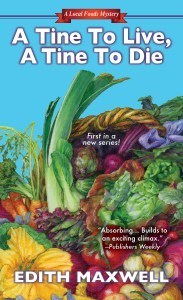 Edith: I had written a very early version of A Tine to Live, a Tine to Die eighteen years earlier in between farming seasons. For the proposal (and the book), I knew I had to rewrite the content, but I was able to keep the fictional world I had set up all those years ago. Protagonist Cam Flaherty, former software engineer. Small rural town. Antique saltbox farmhouse. And death by pitchfork in the hoop house. So I had a head start, and it wasn’t that hard for me to craft the first three chapters. The last chapter of the proposal ends right after my farmer discovers the body. So the tip about that might be: make sure you hook your reader, who you hope will be your publisher, with great storytelling and, if not a body, then something that will really grab them.
Edith: I had written a very early version of A Tine to Live, a Tine to Die eighteen years earlier in between farming seasons. For the proposal (and the book), I knew I had to rewrite the content, but I was able to keep the fictional world I had set up all those years ago. Protagonist Cam Flaherty, former software engineer. Small rural town. Antique saltbox farmhouse. And death by pitchfork in the hoop house. So I had a head start, and it wasn’t that hard for me to craft the first three chapters. The last chapter of the proposal ends right after my farmer discovers the body. So the tip about that might be: make sure you hook your reader, who you hope will be your publisher, with great storytelling and, if not a body, then something that will really grab them.
For my Country Store Mysteries proposal (Flipped for Murder out in November, under pen name Maddie Day!), I had to 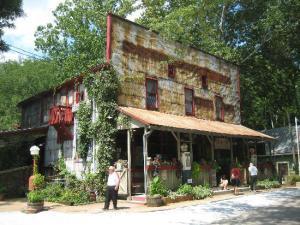 set up the entire world, the protagonist, the supporting characters. But since the series is set in southern Indiana, a part of the universe I love, and because I had a vision for the near-Southern language and way of life, I had a lot of fun with those first chapters. Totally agree with Sherry, though – you have to start with a good hook, and make sure your last paragraph has one, too. The end of the proposal chapters shows a local police officer telling Robbie and her date about the murder of a local official Robbie had had conflict with – and that the victim had one of Robbie’s signature cheesey biscuits stuffed in her mouth.
set up the entire world, the protagonist, the supporting characters. But since the series is set in southern Indiana, a part of the universe I love, and because I had a vision for the near-Southern language and way of life, I had a lot of fun with those first chapters. Totally agree with Sherry, though – you have to start with a good hook, and make sure your last paragraph has one, too. The end of the proposal chapters shows a local police officer telling Robbie and her date about the murder of a local official Robbie had had conflict with – and that the victim had one of Robbie’s signature cheesey biscuits stuffed in her mouth.
Liz: Thanks to the counsel of Avery Aames/Daryl Wood Gerber, I had a good fou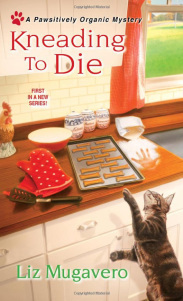 ndation to use when putting my proposal together. And the idea for the Pawsitively Organic Mysteries, which my agent and I both loved, was exciting to me – so the first three chapters were a lot of fun to write. The one thing I struggled with was how much set-up I needed to do versus just jumping right into the story of the murder. I wanted to set the stage for the town and characters enough that readers immediately felt familiar with them, but didn’t want to kill it with a lot of backstory. It ended up that my victim was found at the end of the second chapter, and when I ended the third it was setting up Stan’s situation of being a suspect.
ndation to use when putting my proposal together. And the idea for the Pawsitively Organic Mysteries, which my agent and I both loved, was exciting to me – so the first three chapters were a lot of fun to write. The one thing I struggled with was how much set-up I needed to do versus just jumping right into the story of the murder. I wanted to set the stage for the town and characters enough that readers immediately felt familiar with them, but didn’t want to kill it with a lot of backstory. It ended up that my victim was found at the end of the second chapter, and when I ended the third it was setting up Stan’s situation of being a suspect.
 Barb: Great timing on this question as someone recently asked to see my proposal so I read it again. I was surprised how closely the first three chapters in the proposal were to those that were eventually published in Clammed Up. I remember that I had a lot of fun with these chapters. My agent had emphasized that it was a spec proposal and though he thought clambakes were a subject that should interest publishers, it was by no means guaranteed. So my thought about the first three chapters was–have fun, don’t overthink, don’t get too attached. It’s a fun way to write. The set-up, a wedding, was intended to quell my panic about supplying recipes for a series. A clambake is the same meal over and over and over. I thought if the Snowden Family Clambake Company was the setting for special events, other kinds of food might be served. In the series, I’ve solved this problem in a completely different way, so the wedding was unnecessary, but I’m glad that’s where the series started. Eventually another publisher, who ultimately passed, asked me for three more chapters. Those didn’t end up in the book in the same spot.
Barb: Great timing on this question as someone recently asked to see my proposal so I read it again. I was surprised how closely the first three chapters in the proposal were to those that were eventually published in Clammed Up. I remember that I had a lot of fun with these chapters. My agent had emphasized that it was a spec proposal and though he thought clambakes were a subject that should interest publishers, it was by no means guaranteed. So my thought about the first three chapters was–have fun, don’t overthink, don’t get too attached. It’s a fun way to write. The set-up, a wedding, was intended to quell my panic about supplying recipes for a series. A clambake is the same meal over and over and over. I thought if the Snowden Family Clambake Company was the setting for special events, other kinds of food might be served. In the series, I’ve solved this problem in a completely different way, so the wedding was unnecessary, but I’m glad that’s where the series started. Eventually another publisher, who ultimately passed, asked me for three more chapters. Those didn’t end up in the book in the same spot.
Jessie: There’s a lot of business to accomplish in the first three chapters. Introduction of main and a few supporting characters, the inciting incident and the voice of the novel all need to be present and correct. It can be a bit overwhelming. On the other hand, the story is so fresh and the enthusiasm should be so high that it should be a pleasurable challenge. Which brings me to my best tip: if the first three chapters don’t have you chomping at the bit to tell the story then you should ask yourself if you are telling the right tale. I don’t mean to say that the first draft of these pages should be the most perfect thing you have ever written. I do think, at this stage, your enthusiasm is a strong guidance system and if you don’t have it something is wrong and you should listen. Whether that means tweaking some details, weaving n new story threads or scrapping the whole thing and starting over, it would be wise to set off on a journey you really wish to take. Now is the very best time to do so.
Julie: My first three chapters story is a little different. A year and a half ago I was given the opportunity to audition to write this series. I was given an outline of the characters, and a fairly robust storyline. My job was to show my editor that I could write the series, but also that I could write the series that she had created. So I needed to figure out how to make the story mine, and hers, at the same time. I also needed to figure a way into the story. The series was sold, I just needed to sell my skills as a writer, and a storyteller. Ironically, and interestingly, those first three chapters got me the gig, but I didn’t end up using them in the final product. So my advice, make sure the first three chapters are written really well. If you want someone to give you a contract, they need to trust that you have the craft under control.
Edith again: I love the timing of this post. I am writing the first chapter of the second Country Store mystery this week. Today! And all these comments are helping me.
Readers: What do you want to see in the first three chapters of a mystery? If you’ve written your own first three, what were your joys and challenges doing so?
Filed under: Wicked Wednesday Tagged: A Biscuit A Casket, A Tine to Live a Tine to Die, Avery Adams, boiled over, clammed up, Country Store Mysteries, cozy mystery, Daryl Wood Gerber, enthusiasm, Flipped for Murder, Jessie Crockett, Kensington Publishing, Kneading To Die, Maddie Day, Maine Clambake Mystery, Positively Organic Mysteries, Sarah Winston Garage Sale Mysteries, Tagged for Death, writing proposals

January 13, 2015
Cate Price — Inventive Minds
Welcome Cate Price — thanks so much for stopping by today.
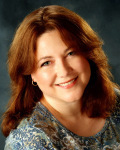 New Haven – Who Knew?
New Haven – Who Knew?By Cate Price
Thanks so much to the Wickeds for having me on the blog today!
 Although I live in Pennsylvania now, I’m originally from Connecticut, and when I went home for Christmas, my mom and I paid a visit to the New Haven Museum. Currently they have an exhibit called “From Clocks to Lollipops”, a wonderful showcase of objects, advertisements, and photographs of consumer goods produced in New Haven over the past three hundred years.
Although I live in Pennsylvania now, I’m originally from Connecticut, and when I went home for Christmas, my mom and I paid a visit to the New Haven Museum. Currently they have an exhibit called “From Clocks to Lollipops”, a wonderful showcase of objects, advertisements, and photographs of consumer goods produced in New Haven over the past three hundred years.
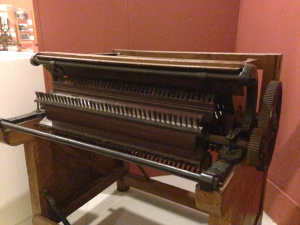 You may already know that the Cotton Gin was invented by Eli Whitney, a Yale graduate, who patented his device to separate cotton from seeds, and built an armory north of the city that would become the first modern American factory.
You may already know that the Cotton Gin was invented by Eli Whitney, a Yale graduate, who patented his device to separate cotton from seeds, and built an armory north of the city that would become the first modern American factory.
But did you also know that lollipops were invented in New Haven by the Bradley Smith Company, originally trademarked as “Lolly Pop”?
Or how about the Erector Set, that classic toy in a bright red steel case? It was produced by A.C. Gilbert, who graduated from Yale with a medical degree. It was the most popular gift for boys in 1954. The A.C. Gilbert Company also made the Atomic Energy Set and American Flyer model trains.
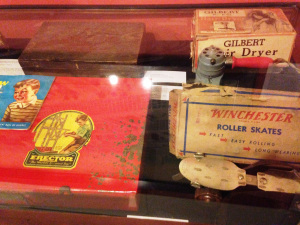 Other innovations in commerce connected to New Haven include the mortise lock, truss bridge, corkscrew, stone crusher, carriage spring, match book, telegraph, bicycle crank, corset, processed rubber, lever action rifle, toy motor, Silly Putty, metronome, and more. Who knew?!
Other innovations in commerce connected to New Haven include the mortise lock, truss bridge, corkscrew, stone crusher, carriage spring, match book, telegraph, bicycle crank, corset, processed rubber, lever action rifle, toy motor, Silly Putty, metronome, and more. Who knew?!
The museum also has an exhibit about “Deane Keller, New Haven’s Monuments Man”. He was an art professor from Yale who was dispatched to Italy during WWII as part of an international effort to save precious works of European art from the Nazis. His story was largely unknown until the release of the film “The Monuments Men” starring George Clooney.
Another interesting room is “Nothing is Set in Stone: The Lincoln Oak and the New Haven Green”. In 2012, Hurricane Sandy brought down the mighty oak tree on the Green that had been planted in 1909 to commemorate the 100th anniversary of Lincoln’s birth. Area artists were invited to use salvaged pieces of the tree to create original art projects and the beautiful results are on display.
The New Haven Museum is really worth a visit if you’re in the area. It’s located at 114 Whitney Avenue, New Haven, CT 06510. (203) 562-4183.
Readers: What was invented where you live?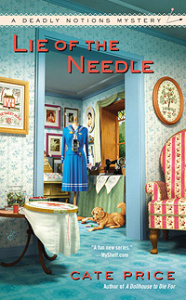
Cate Price is the author of the Deadly Notions mysteries from Berkley Prime Crime, about the proprietor of a vintage sewing notions shop located in Bucks County, PA. LIE OF THE NEEDLE, the third in the series, was published on January 6, 2015.
She loves to hear from readers via her website http://www.cateprice.com or on Facebook at http://www.facebook.com/catepriceauthor
Filed under: Guest posts Tagged: A.C. Gilbert, Atomic Energy Set, Berkely Prime Crime, Bradley Smith Company, Bucks County PA, Cate Price, Connecticut inventors, Cotton Gin, Deadly Notions, Deane Keller, Eli Whitney, Erector Set, From Clocks to Lollipops, Lolly Pop, New Haven Museum, Nothing is Set in Stone: The Lincoln Oak and New Haven Green, threads of evidence, Yale

January 12, 2015
Lucky
By Liz, wishing for spring in Connecticut
Lately I feel like a walking self-help book. At least in my own head. Affirmations, sayings, mantras are all spinning around in a big jumble in my brain, the result of a desperate attempt to keep everything under control and smile while I’m doing it. 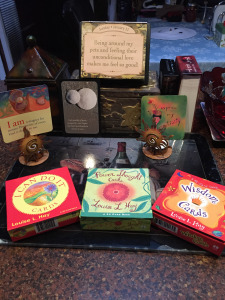
I have a tendency to get carried away by my thoughts – must be a writer thing – but when the deadlines are fast approaching, time seems to slip away and the to-do list is piling up instead of slimming down, those thoughts sometimes turn scary. Like, how the bleep am I ever going to get this all done?
But I knew this was a possibility. I planned for it. I tried – and succeeded – in getting a jump on both book deadlines. I am not procrastinating (that much, anyway). I am plotting like a fiend so I don’t get stuck in the mires of the middle and flounder, wasting time and energy. I am also constantly trying to reprogram my thoughts with the help of some of the greats.
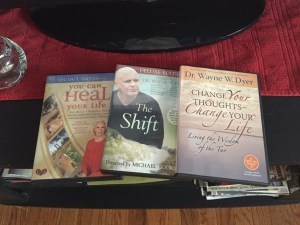 Jessie Crockett wrote last week about bingeing on favorite TV episodes. Since New Year’s Eve, I’ve been bingeing too – but on motivational gurus like Dr. Wayne Dyer, Louise Hay and the like, all in hopes of keeping my monkey brain under control. I’ve dabbled in practices that I’ve either tried before or heard of that sounded good. Things like choosing an empowering word and focusing on that whenever my brain tries to derail itself. I actually picked two words: Inspired and effortless. Inspired to remind myself that the answers to all my plot problems will come if I just get out of the way, and effortless to remind myself that if I just focus my energy in a positive fashion, it will all get done.
Jessie Crockett wrote last week about bingeing on favorite TV episodes. Since New Year’s Eve, I’ve been bingeing too – but on motivational gurus like Dr. Wayne Dyer, Louise Hay and the like, all in hopes of keeping my monkey brain under control. I’ve dabbled in practices that I’ve either tried before or heard of that sounded good. Things like choosing an empowering word and focusing on that whenever my brain tries to derail itself. I actually picked two words: Inspired and effortless. Inspired to remind myself that the answers to all my plot problems will come if I just get out of the way, and effortless to remind myself that if I just focus my energy in a positive fashion, it will all get done.
I posted a quote in my writing area that one of my favorite teachers from grad school shared with us: Not without doubt, but in spite of doubt. A reminder that everyone in a creative endeavor feels that weight of “how will I ever get this done” but pushes on anyway, and gets it done.
I’ve also tried meditation in small doses – not my strong suit. I’ve latched on to Louise 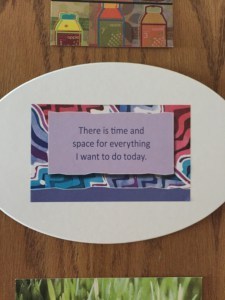 Hay’s affirmation There is plenty of time and space for everything I want to do today. When I’m feeling overwhelmed, I’ve tried retreating to a quiet space, lighting some candles or doing something else aesthetically pleasing, and focusing on writing while keeping in mind the most important thing – this is what I love to do, and I’m blessed to be doing it.
Hay’s affirmation There is plenty of time and space for everything I want to do today. When I’m feeling overwhelmed, I’ve tried retreating to a quiet space, lighting some candles or doing something else aesthetically pleasing, and focusing on writing while keeping in mind the most important thing – this is what I love to do, and I’m blessed to be doing it.
Julie Hennrikus wrote a lovely post before the holidays about finding joy in what you’re doing instead of focusing on the next thing – a message I’ve kept in the forefront of my mind. In the same vein, I had a conversation with a friend recently who has been doing some coaching work. She shared a practice with me called The Power of a Better Question, all about corralling any negative thoughts and turning them into questions that promote positive answers. I’m still thinking through my power questions, but there is one that I’ve decided will be my mantra: How did I get so lucky?
This can apply to all areas of my life depending on where the overwhelm is coming from, but as the deadlines start to close in and the book doesn’t seem to be moving in the right direction, it’s especially pertinent. I am seeing my dream of being a published author come true. I have two series under contract, and countless possibilities ahead of me. And when I look at it that way, the deadlines don’t seem so scary anymore.
It will all get done. And I am very lucky.
Readers, how do you counter feelings of stress and overwhelm?
Filed under: Liz's posts Tagged: affirmations, deadlines, happiness, Joy, Louise Hay, positive thoughts, Wayne Dyer

January 9, 2015
Opening Lines Photo Contest
 We have a lot of fun with our Opening Lines blogs so we decided to have a contest for those of you who love to take pictures. You can enter one picture. Email your entry to sherryharrisauthor@gmail.com no later than midnight on January 31st. The winner’s picture will be featured (along with a bit about the photographer and a photo credit) on February 13th, runners up over the next several months. You can take a look at our former Opening Lines blog posts by typing Opening Lines in the search box.
We have a lot of fun with our Opening Lines blogs so we decided to have a contest for those of you who love to take pictures. You can enter one picture. Email your entry to sherryharrisauthor@gmail.com no later than midnight on January 31st. The winner’s picture will be featured (along with a bit about the photographer and a photo credit) on February 13th, runners up over the next several months. You can take a look at our former Opening Lines blog posts by typing Opening Lines in the search box.
I often look at the background of pictures I’ve taken or crop pictures to use on the blog. Here is an example:
The original picture isn’t that interesting:
 But I noticed all the people in the background and this was the picture we used:
But I noticed all the people in the background and this was the picture we used:
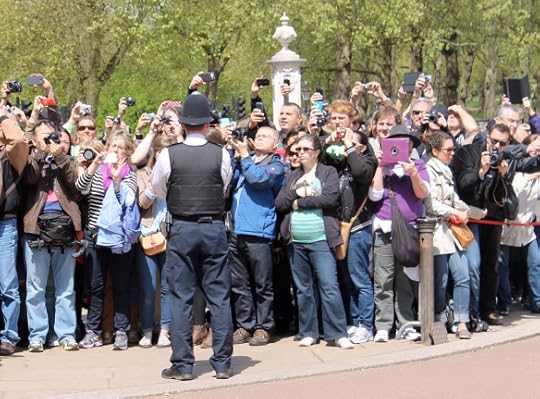 It got some pretty funny responses that you can read here. It’s amazing how people see different things in the same picture! So send us one of your favorite photos. If you have any questions leave them below in the replies or email me!
It got some pretty funny responses that you can read here. It’s amazing how people see different things in the same picture! So send us one of your favorite photos. If you have any questions leave them below in the replies or email me!
Filed under: Opening Lines Tagged: contest, opening lines, Opening Lines contest, photography contest

January 8, 2015
To Binge or Not to Binge?
Jessie: Trying to hear myself think over the chattering of my teeth in the frozen north.
Sometimes it is just too cold and dark to consider leaving the the house. Often in the depths of winter it can be a trial to pry oneself from the warmth of a comfy bed. Such times are custom made for Netflix or Hulu binge watching.
Diving headlong into other times, other lives and even other worlds is so appealing that it’s tempting to watch episode after episode until you’ve forgotten where you are and maybe even who. With all the exotic locations, lavish lifestyles and sumptuous costumes to enjoy why would you want to remember everyday life anyway?
The only problem is, just like that, you’ve reached the end of the available episodes. You’re left blinking and disoriented by the total lack of Vikings or Prohibition era gangsters in your living room. There are no bells to ring for white capped maids, no air raid shelters, no consultations at 221B Baker St.
So, readers, my question is this: is it better to binge or not to binge on your favorites? The pleasure of immersion vs. a more sedately paced building of Houses of Cards, visits to Lilyhammer and even family reunions with the Sons of Anarchy? Do you derive more pleasure from spreading out your preferred indulgences or do you race through one series and then go looking for a new passion? Do you do the same with book series or even favorite authors? And of you do prefer to binge, do you ever get tired of a series before you reach then end of it in a way you might not if you spread the watching out over more time?
Filed under: Uncategorized Tagged: binge watching, House of Cards, Lilyhammer, Sons of Anarchy, television watching, Vikings

January 7, 2015
Wicked Wednesday- Writing The Dreaded Synopsis
Jessie- Cheering herself with the notion that the shortest day of the year is already behind us in the Northern Hemisphere!
This month we’ve decided to all chime in on the process of writing proposals for book series. Mystery series are often sold this way, in fact all of us have sold series in this manner, some of us more than once. The format for doing this is fairly standardized in the publishing industry and each Wednesday this month we will dive into one aspect of the process. This week is the Dreaded Synopsis. For those readers who may be unfamiliar with the term, the synopsis is the part of the proposal where the writer distills the idea for an 80,000-word novel down to less than a page. So, Wickeds, how do you approach a task like that?
Edith: It ain’t easy, and I’m still learning how to write one. As a writer who mostly follows the “write into the headlights” approach – that is, I write by the seat of my pants – I have a hard time describing the main conflict, the main characters, and the resolution in advance of actually writing the book. A couple of guidelines I learned early on were: name as few characters as you can get away with. Use “the brother” or “the chef” so you don’t confuse the one-page story line with a bunch of names. Also, my editor at Kensington wants to know the beginning, middle, and end and doesn’t let me get away with turning in anything less than that for the synopsis. Luckily, if those bits change as I write the book, it’s usually fine with him, as long as I update the synopsis by the time I turn in the manuscript, or even sooner.
Liz: At first I thought writing a synopsis was a terrible punishment for something – I wasn’t quite sure what. When I wrote the first one for my editor (same as Edith’s) I did it because I had to. But as I was writing, I found it very helpful to have that roadmap, even if the pieces did change as I went along. Now, I find it helps more than it hurts, even when it feels like pulling teeth when I’m in the middle of it. As a self-proclaimed pantser, I’m teetering on the edge of liking things plotted out. It definitely helps when you’re juggling a lot of deadlines and other aspects of life.
Julie: I am a plotter, and writing with a bible, so the synopsis is a little less painful for me. For the sake of the synopsis, it is a question of boiling it down to its essence. Make it intriguing. Mention the characters. Hint at the subplots. For this purpose, you need to tell all. Don’t be coy–you are trying to convince someone that you can tell the whole story.
Sherry: Ask a published author if you can borrow their synopsis. I was very lucky to be able to read through Liz, Edith, and Barb’s synopsis before I wrote mine. The synopsis for my first book was four pages and poured out of me. The second book was much more difficult and Barb gave me some excellent advice in my blog about plotting. I return to this advice time and time again.
Jessie: I pretend I am once again in elementary or middle school and have been assigned to write a one page book report. The only catch is that the book hasn’t been written yet and I’m the author. It is sort of an out-of-body experience but I generally like that kind of thing. I also like to think of a tagline for the book or even the entire series before I work on the synopsis. Having to distill a story down to a single run-on sentence makes a whole page feel limitlessly voluptuous.
Barb: Sherry’s already given away my advice, and it’s the only advice I have. As a recap, it’s the first three steps that are important.
Pretend you are in a bar with an old friend you haven’t seen in awhile.
Start like this, “You wouldn’t believe what happened to my friend Julia (or Sarah, or Stan, or whatever your protagonist’s name is)…”
Then start the story.
The key to the bar story is, you keep the details to a minimum to avoid confusing the listener, you tell the story in a compelling way designed to entertain, you tell it in your voice, and you try your best to do justice to the story so your listener understands how absolutely amazing, sad, and life-changing these events were for the person they happened to.
Readers–any synopsis writing advice? Any questions for us?
Filed under: Wicked Wednesday Tagged: book bible, Kensington Publishing, plotting, synopsis, writing a synopsis

January 6, 2015
Happy Book Birthday — Susannah Hardy!
We are so happy to celebrate the release of Feta Attraction by debut author (and fellow New Englander) Susannah Hardy (aka Jane Haertel)!
 When did you start writing?
When did you start writing?
Other than school assignments, my writing career began in high school, when I produced a comic strip based on a biology-loving superheroine who wore a plastic microscope cover on her head. I also produced a couple of dreadful short stories and some deliberately bad poetry (one line I recall is: A porkpie hat settles effortlessly to the ground). I am grateful that all of this drivel has been lost to time and to the cleaning efforts of one of my younger sisters who moved into my bedroom when I moved out. I started writing seriously, with the intent of completing a novel, about five years ago, after my son was old enough to not need me so much and preferred hanging out with his friends more than his parents.
Did you always want to write a novel?
Yes and no. Reading was always a huge part of my life, whether I was being read to by a favorite aunt or later when I learned to recognize words on a page. The dream of actually writing a novel of my own came later—because writing was something other people did. People with muses, and some innate desire and talent that mere mortals such as myself did not possess. But in my adult life, the deep-down want was always there. I just didn’t know how to make it happen. So I wrote in fits and starts (I have a virtual drawer full of the first chapters of manuscripts). Finally, I took stock of myself and realized that if I died without having written a complete novel, I would regret it. And so I joined a writing group at the local library, and found a friend who is still a bestie to this day, and we started the writing journey together. As much as writing is a solitary undertaking, I don’t know anyone who can do it alone. After I’d completed a manuscript, I joined a professional organization (RWA) that taught me the business side of writing and that made all the difference in helping me make the transition from writer to professional writer.
How did you find your agent?
I had been sitting on the manuscript that became FETA ATTRACTION for a while (like a couple of years!), continuing to trim unnecessary stuff and tweaking the beginning until it fit the cozy mystery genre. Finally, I realized I needed to let go of my perfectionism and push myself to try to sell it, so I gave myself a deadline—six months to find an agent or a digital-first publisher, or I would indie publish the novel. Either way, it was time to move on to something else. So I took a targeted approach. I went to the cozy mystery section in Barnes and Noble and looked at every book on the shelf, checking the acknowledgements to see if the author thanked her agent. This gave me a list of professionals I knew could sell my book, and I submitted to all of them, plus the major digital-first publishers. I got some rejections, and some requests for partials and fulls.
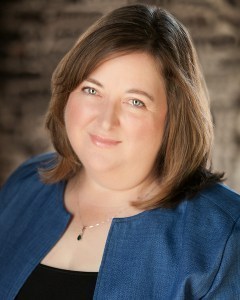 During this time I attended Crime Bake, the annual conference put on by Sisters in Crime and Mystery Writers of America. A friend introduced me to her agent, and he requested that I submit to him, which I did after the conference. He loved the premise and the book, and offered me representation. Exciting, right? Except, I did some research on him and realized he’d never sold a cozy mystery. This isn’t to say he couldn’t do it, just that he never had. But this put me in a great position. I went back to all the top agents I had targeted previously and let them know that I had an offer from someone else. This moved me up in their queues, so to speak. John Talbot called me and when I spoke to him, I knew immediately he was the agent for me. We put together a proposal, and two weeks after I first spoke to John, we had a deal with Berkley. And I had two months left on my personal deadline, LOL!
During this time I attended Crime Bake, the annual conference put on by Sisters in Crime and Mystery Writers of America. A friend introduced me to her agent, and he requested that I submit to him, which I did after the conference. He loved the premise and the book, and offered me representation. Exciting, right? Except, I did some research on him and realized he’d never sold a cozy mystery. This isn’t to say he couldn’t do it, just that he never had. But this put me in a great position. I went back to all the top agents I had targeted previously and let them know that I had an offer from someone else. This moved me up in their queues, so to speak. John Talbot called me and when I spoke to him, I knew immediately he was the agent for me. We put together a proposal, and two weeks after I first spoke to John, we had a deal with Berkley. And I had two months left on my personal deadline, LOL!
Did you write your novel before submitting it to your agent? Or did you submit a proposal?
FETA ATTRACTION was finished when I submitted. I also had synopses done for the next two books in the series. This was a huge advantage when it came time to put the proposal together for the editor and that’s part of the reason I was able to sell it so fast.
What appealed to you about the cozy mystery genre?
I don’t just write cozies—I read them, and I love them! I love the small communities, and the recurring characters, and that the cozies are published in series, because it is so much fun to come back to all the characters who survived the curse of living in that small community, LOL! But the thing I love best is that justice is always served. There’s always a satisfying resolution, and the bad guy or girl always gets comeuppance. In a real world where horrible things happen every day and get plastered over the news media and rehashed and analyzed to excess, the ability to escape into a cozy mystery where justice is dispensed in the end is a real gift.
How did you develop the recipes for your book?
I’m not Greek, and neither is my heroine, so there was a bit of a learning curve, although Greek food is generally simple to make—yet very complex in its simplicity, LOL! I do lots of digging around on recipe sites and people’s personal blogs, and find tons of recipes that I can play with as a starting point. When I find one that looks promising, I try it out on my family, making a few tweaks to make it my own. Then I write out the ingredients and the instructions, let them sit for a day or two, then go back and double check them to make sure I didn’t write “baking powder” when I meant “baking soda,” as happened to me recently. Not surprisingly, working on the recipes is one of the most fun parts of writing my series!
What has been the most surprising thing about the publication process?
That I’m actually part of the publication process. I’m still pinching myself.
How did you come up with your pen name? And why are you using one?
I chose the name of my great-great-great grandmother, Susannah Pickard Hardy. I don’t know much of anything about her except that her father was a Revolutionary War veteran, entitling me to get into the DAR someday! And I liked her name. I took a pen name when I first started blogging and writing, because my maiden name is politically controversial (even though any possible relationship is very remote), and my married name has an unusual Germanic spelling that I thought would make it difficult for readers to find me.
What’s next?
Books 2 and 3 in the Greek to Me Mysteries are in the queue. And I’m developing a proposal for a new cozy mystery series that I’m really excited about. Fingers crossed this one sells, because it’s going to be a lot of fun and I love my heroine already.
Thanks for having me here today, Wickeds! It’s always fun to visit with you.
Susannah is a member of the New England Chapter of Sisters in Crime, the Romance Writers of America and the Connecticut Chapter of RWA. Susannah is originally from Northern New York State (Way north! Only a few miles from the Canadian border), graduated from St. Lawrence University, and now lives in Connecticut with her husband, teenaged son, and Elvira the Wonder Cat.
Readers: Susannah will be stopping in all day to answer questions.
Filed under: Guest posts Tagged: Book birthday, book launch, Feta Attraction, Susannah Hardy


